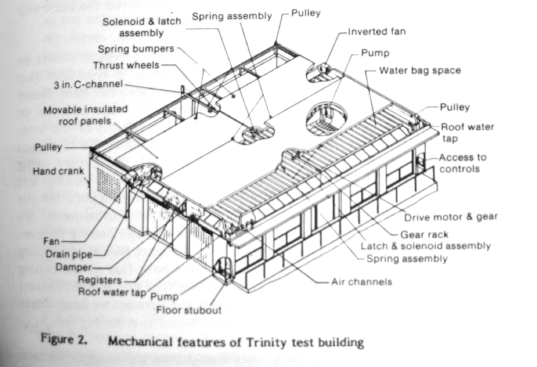In his 1976 “plowboy interview” with Mother Earth News, chemist Harold R. Hay touted his Skytherm invention as a preferable alternative to traditional building heating and cooling systems. According to Hay, the problem with established HVAC approaches is that they “overpower the climate”—rather than working with it—by consuming large quantities of energy to ensure indoor comfort. Hay’s Skytherm is a passive system that conditions space without electricity, pumps, circulating fluids, or noise. It consists of a large roof pond, contained in a plastic bladder, that is covered by movable insulation panels. During hot days, the panels are closed to keep the sun out while the water absorbs heat from the house. At night, the panels are moved aside to allow the pond to radiate the heat into the night sky. (In the winter, this process is reversed.)
Based on a scientific phenomenon known as radiative cooling, this method has been employed for centuries by builders in North Africa and the Middle East but has been largely forgotten in modern times. In Hay’s system, no energy is required to lower a building’s temperature. Traditional Iranian courtyard architecture was cooled by this strategy, for example, and builders in India harnessed the method to produce ice in above-freezing conditions. Given radiative cooling’s remarkable zero-energy potential, it is a wonder why Skytherm is not employed en masse today. One reason is the abundance of cheap fossil fuels that became available in the late 1970s; another is the reported maintenance challenges with Hay’s system, including leaky bladders. Nevertheless, today’s troubled energy outlook has motivated a renewed interest in radiative cooling as a passive conditioning strategy for architecture.

Wikimedia Commons
Sketch of a proposed Skytherm system at Trinity University in Texas, as featured in the "Passive Solar Journal"
Not only are buildings major contributors to global warming, but the growing use of air conditioning has created a negative spiral effect. More air conditioning means more energy consumption, which further warms the atmosphere, leading to more air conditioning, and so on. The U.S. Energy Information Administration expects that the most rapid increase in energy use will come from air conditioning. “Growing demand for air conditioners is one of the most critical blind spots in today’s energy debate,” says Fatih Birol, executive director of the International Energy Agency. “Setting higher efficiency standards for cooling is one of the easiest steps governments can take to reduce the need for new power plants, cut emissions, and reduce costs at the same time.” By 2050, the IEA anticipates that two-thirds of international households will own an air conditioner—leading to a global “cold crunch.”
While the IEA recommends increasing air conditioning efficiency, strategies like radiative cooling can reduce the demand for air conditioning altogether. Cool roofs—roof surfaces with a high solar reflectance—represent one of the most common building strategies to remove heat passively, especially in hot climates. Consisting of light-pigmented, reflective materials such as elastomeric latex coatings, cool roofs typically exhibit a thermal emittance (the capacity to release absorbed heat) of 85% or more. The challenge with commercially available cool roofs is that they still absorb heat energy—thus canceling some of the benefits of thermal emission.
This is what inspired UCLA materials scientist Aaswath Raman to engineer a material so reflective that it absorbs virtually no energy in full daylight. The new material also emits heat at a particular wavelength not blocked by the earth’s atmosphere, allowing it to radiate back into the sky without increasing the ambient air temperature. This exceptional combination of properties is made possible by nanotechnological engineering, resulting in multilayered, light-directing polymer films. Not only does Raman’s invention outperform conventional cool roofs, but it also overcomes one of Skytherm’s limitations. “The first big puzzle was figuring out how you can make use of [the radiative cooling] effect when we need [it] the most—during the daytime,” said Raman in a UCLA press release. “Historically, radiative cooling was called ‘night sky cooling,’ because that’s when we notice the effect.” In contrast, Raman’s material stays cooler than the ambient air temperature during the day—even when exposed to direct sunlight.

SkyCool
SkyCool panels

SkyCool
Panel systems installed by SkyCool
Raman launched the company SkyCool Systems to produce the technology commercially, and several pilot projects have demonstrated initial success. For example, an installation on a Grocery Outlet store in Stockton, Calif., reduced the facility’s electricity bill by $3,000 this past summer—not a staggering amount, but impressive given the store’s intense cooling needs. Raman has also developed a method to use the stored heat of building materials to generate nighttime electricity. Although this counterpart technology produces minimal electricity, the benefits could be meaningful in some contexts with constrained solar access. “In polar regions, for instance, you could power sensors or small lights for decades without worrying about having to replace the battery,” Raman said.
Other researchers are also developing advanced radiative cooling technologies. Scientists at Columbia University, Argonne National Laboratory, and Brookhaven National Laboratory have devised a paintable polymer—made from porous poly(vinylidene fluoride-co-hexafluoropropylene), or P(VdF-HFP)HP—that can achieve a 6°C reduction in ambient temperature and a cooling potential of 96 watts per square meter. A team from the University of Colorado at Boulder and the University of Wyoming has developed a composite metamaterial consisting of polymer-encapsulated microspheres with a silver film backing. The substance exhibits a radiative cooling of 93 watts per square meter in direct sunlight.
These promising advances demonstrate some of the fundamental benefits that nanotechnology is bringing to architecture. It may also help overcome some of the real or perceived maintenance hurdles of Hay’s Skytherm system, with the newfound capacity to cool during the daytime. Most importantly, these new radiative cooling materials can mitigate the intensity of our seemingly unstoppable negative energy spiral—a big concern if we are going to find a solution for climate change.
